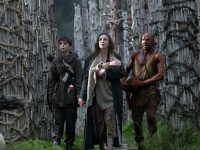
 Formed in 2003 in a dilapidated log cabin, Wolves In The Throne Room is the project of brothers Aaron and Nathan Weaver, and Kody Keyworth. Touted as ‘Cascadian black metal’, the band are experts in leaving behind the Satanic and occult death-based imagery from traditional black metal in exchange for more spiritual and almost natural elements. But for such a potentially niche market, how well does their new album, Thrice Woven, hold up?
Formed in 2003 in a dilapidated log cabin, Wolves In The Throne Room is the project of brothers Aaron and Nathan Weaver, and Kody Keyworth. Touted as ‘Cascadian black metal’, the band are experts in leaving behind the Satanic and occult death-based imagery from traditional black metal in exchange for more spiritual and almost natural elements. But for such a potentially niche market, how well does their new album, Thrice Woven, hold up?
“Born from the Serpent’s Eye” is a track that could quite easily – at least from the outset – be mistaken for a soundtrack from a dramatic period piece for its avant-garde style strings, not unlike a plucked and strummed lute. Alternatively, you could liken it to a piece of music from a battle scene from an anime, for the sheer drama of it, shot through with an electric guitar that wouldn’t be out of place in speed metal. Add a set of rasping vocals and a relentless, thrash metal drumline and you’re left with something that, on paper, sounds like nothing but a mess. However, through either luck or judgement, Wolves in the Throne Room manage to pull it off. After surviving the onslaught of the first four minutes, we’re dropped into a choral piece for a brief respite with a twinkling melody at its back before the simply gigantic guitar riff returns to take us towards the end of this nearly 10 minute long epic.
With a spoken word piece about the change of the seasons and alterations in the world, “The Old Ones Are With Us” may as well be starting with a passage from Game Of Thrones, along with a subtle organ and choral backdrop, retaining the same rasping vocals from “Born from the Serpents Eye”. The guitar and bass melody in this piece is reminiscent of work from post-rock gods, If These Trees Could Talk and makes for a deep and immersive soundscape. Much like the first track, the midway mark acts like the eye of a storm, a slow, almost tranquil break – in this instance filled with organs and spoken word – before we are plunged back into the dramatic and massive scope of the latter half of the song.
It is worth mentioning here, that the album is only five songs in terms of track list. However, this doesn’t relinquish anything in terms of running time, still standing at a respectable 42 minutes. Wolves In The Throne Room specialise in gigantic, almost operatic pieces that demand attention.
At just over 10 minutes, “Angrboda” is still only the second longest track on the album. With a relentless assault from the get-go, the song bears similarity to some tracks from math-rock pioneers Meshuggah, with nods to their influence in the form of a constant double bass drum rhythm and guitar melodies that weave in and out of one another whilst orchestral strings and percussion punctuate the piece. Unlike the previously mentioned ‘eye of the storm’ from the previous tracks, here we are left with naught but a descent in both timbre and frequency, featuring a bassline so low it will test even the most agile floorstanding speakers (or simply sound awesome through an accompanying sub; this reviewer used a REL T5i).  The second half of the song comes with no real lull, but sound effects of dropping water, like you’d been led into cavern that’s filled with echoing strings and flute music…and also has a resident metal guitarist. Strange analogy aside, the soundtrack-worthy piece keeps the energy up throughout and does both justice and homage to the influences from doom metal it showcases towards the end.
The second half of the song comes with no real lull, but sound effects of dropping water, like you’d been led into cavern that’s filled with echoing strings and flute music…and also has a resident metal guitarist. Strange analogy aside, the soundtrack-worthy piece keeps the energy up throughout and does both justice and homage to the influences from doom metal it showcases towards the end.
Sitting at nearly a quarter of the length of the other tracks, the light and choral “Mother Owl, Father Ocean” serves as an interlude between the depths of “Angrboda”, and the final, towering track, “Fires Roar in the Palace of the Moon”.
At a length of 11:30, the track is the longest on the album and launches from the almost peaceful point of “Mother Owl, Father Ocean” into a blistering blend of speed drums and wailing, thrashing guitars spiked with harsh, growled vocals. This staggering blend doesn’t let up until a static-filled break just under the halfway point, filled only with crackles, high pitched screeches and the swell of a vintage amplifier before hurtling back into the main body of the song. As the final minutes of the song approach, the music is exchanged for the sounds of nature and static before fading out.
Overall, the album is quite simply staggering. The songs are at no point a bore due to their length and if attention is given, it will be rewarded.

Author: Steve, Southgate store





